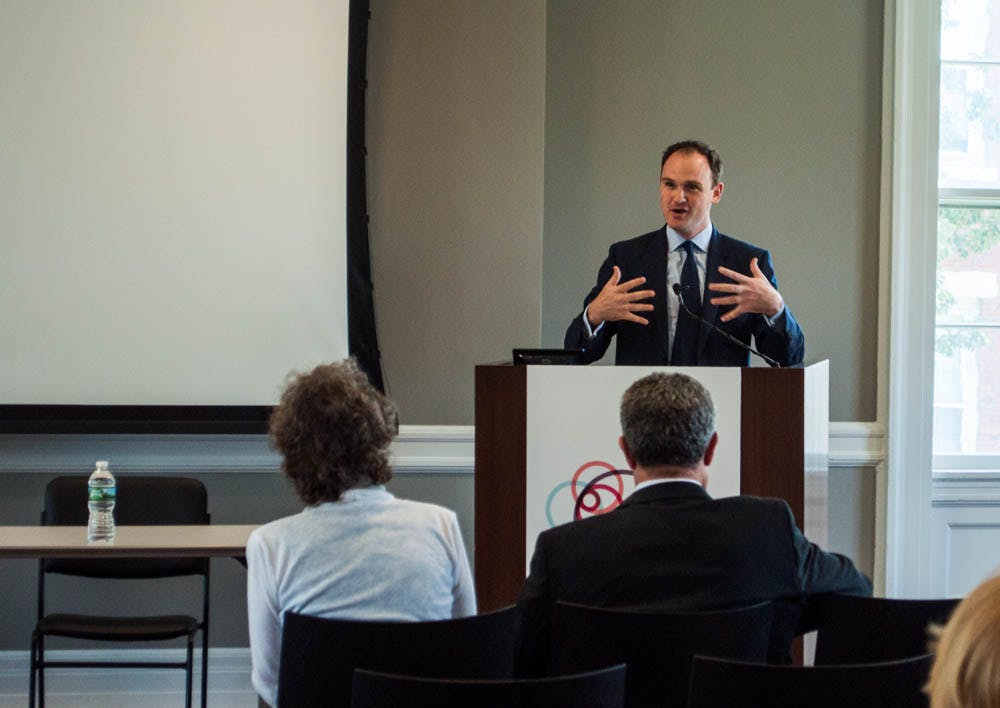Local and national leaders in the prison education movement convened Friday morning to discuss their experiences, ideas and challenges as they sought to strengthen and create programs that provide higher education to incarcerated populations.
“He who opens a school door closes a prison,” quoted Amy Remensnyder, professor of history and founder and director of the Brown History Education Prison Project. Split into two parts, the conference was devoted to exploring the current state of prison education in Rhode Island and learning from the country’s leading institutions to understand the greater role that the University can play in serving the state’s incarcerated population of more than 3,000 people.
Remensnyder opened the event by urging the audience to consider the “transformational effect” that prison education programs have on not only incarcerated people but also those who teach in prisons, such as herself.
She highlighted the ways that the University is already involved in prison education, such as through the Petey Greene Program — an in-prison tutoring program in which undergraduates tutor students in the Adult Correctional Institute — and BELLS, another name for the Brown History Education Prison Project, where faculty members from the history department co-teach non-credit history classes at the ACI.
But Remensnyder noted that “we are eager to learn ways we can expand our role at Brown.”
The first panel, titled “Teaching in the Prisons,” examined the prison education programs currently in place in Rhode Island, as well as other initiatives at Cornell and Princeton.
Ralph Orleck, special education director and principal of the Rhode Island Department of Corrections, highlighted the need for correctional education in the state and added that evidence shows that inmates participating in education programs have lower re-incarceration rates.
Will Jackson, college program coordinator of the RIDC, focused on the nuances of creating a successful prison education program while building upon the current partnership the state has with the Community College of Rhode Island.
He noted that the lack of resources, both financial and political, presents challenges for replicating quality higher education programs, such as Prison University Project in San Quentin, California.
“Creative fundraising is imperative to being able to run higher education programs,” Jackson said, adding that there is currently only a “patchwork approach.”
Other aspects of college are not possible in the prisons, such as residential communities, Jackson said, adding that the lack of Internet hinders real research opportunities. But Jackson is heartened that even though instructors are challenged in this setting, they often leave saying “that was one of the best classes I’ve ever had.”
“In the end, it is a winning situation,” Jackson added.
Rob Scott, the executive director of Cornell Prison Education Program, spoke about the “special role” that the University has to play and possible ways to go about it.
Brown can serve “networking functions” by providing advising and help in navigating financial aid bureaucracy as well as by creating an environment of excitement through events such as bringing in a dean for a guest lecture, Scott said.
During the roundtable discussion, these panelists addressed questions about the logistics and impact of these prison education programs.
Scott and Jill Stockwell, doctorate student and volunteer teacher for Princeton’s Prison Teaching Initiative, described the various changes their respective programs are hoping to implement, such as having an honors program through Cornell and credit-bearing courses at Princeton.
The second panel, “The Prison-to-College Pipeline,” focused on what happens after people are released from prison, said Emily Esten GS, a first-year public humanities graduate student.
During the discussion, participants and panelists noted that some terms, such as recidivism and success, can have complex meanings depending on the context of a college or prison setting. Defining and measuring success based solely on recidivism rates can be one-sided and incomplete, said several panelists.
Recidivism is a “very baggy term,” said Baz Dreisinger, founder and academic director of John Jay’s Prison-to-College Pipeline Program.
Success for a former inmate includes “many intangibles that are hard to measure,” Dreisinger said, adding that they conduct case studies to see the larger picture.
Speakers also addressed how colleges and universities involve public policy to advance these prison education programs.
Christina Dawkins, program manager of the Justice-in-Education program at Columbia, noted that they have been campaigning to reduce aging people in prison and remove “the box” on the Columbia application that one must check if charged with a felony.
Dreisinger said that the impact on public policy could be indirect, by producing a “justice army” of people who can advocate for these programs.
The consensus among speakers seemed to be that the University and other similar institutions have not only a role in the prison education movement but also a “duty,” wrote Sarah Cantor, an audience member, in an email to The Herald.
Max Kenner, founder and executive director of the Bard Prison Initiative, closed the conference by urging that advocates should keep whom they are serving, not where they are serving, as the focus of their efforts in the prison education movement.
“Assume ambition and capacity, not being formerly incarcerated,” Kenner said. “We shouldn’t be in the business of crime prevention but in finding fabulous students.”
“The more we focus on the prison, the more the education we provide will be perverted,” he added.
Acknowledging the longstanding American belief that education is the route to a better future and freedom, Kenner noted that “some have known it more than others.” At an institution like Brown, he said, it is our “burden” to find students who will take the most advantage of a small amount of opportunity.
The conference was co-sponsored by the Royce Family Professorship of Teaching Excellence, the Center for the Study of Slavery and Justice and the Office of Institutional Diversity and Inclusion.





